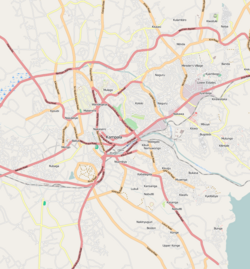Banda, Uganda
| Banda | |
|---|---|
| Location in Kampala | |
| Coordinates: 00°21′14″N 32°37′57″E / 0.35389°N 32.63250°E | |
| Country |
|
| Region | Central Uganda |
| District | Kampala District |
| Division | Nakawa Division |
| Elevation | 4,070 ft (1,240 m) |
Banda is a hill that lies in Nakawa Division, within Kampala, the capital of Uganda, the third-largest economy in the East African Community. Banda also refers to the neighborhoods on the slopes of the hill and between Banda Hill and Kireka, extending all the way to the Kampala-Jinja Highway. The southwestern slopes of the hill are occupied by the neighbourhood known as Kyambogo, and is the location of the campus of Kyambogo University, one of the nine public universities in the country.
Banda is bordered by Kiwaatule to the north, Kireka to the east, Kinnawattaka to the southeast, Mbuya to the south, Nakawa to the southwest, Ntinda to the west and northwest. The location of the hill is approximately 11 kilometres (6.8 mi), by road, east of Kampala's central business district. The coordinates of Banda Hill are:0°21'14.0"N, 32°37'57.0"E (Latitude:0.353889; Longitude:32.632500).
The full name of Banda is Bandabalogo. Prior to the arrival of the Europeans, Kabaka Muteesa I Mukaabya Walugembe Kayiira, the 30th Kabaka of the Kingdom of Buganda, who reigned from 1856 until 1884, maintained a palace on the hill. It was at this palace that British explorer John Hanning Speke met Kabaka Walugembe Muteesa I in 1862. Muteesa detained Speke for some months before finally releasing him in his quest to look for the source of the Nile River. At Banda, Muteesa faced many misfortunes, which he attributed to ill luck or witch-craft, thus the name Bandabalogo ("Wizards of Banda"). He left Banda and built another palace at Nabulagala which he later called Kasubi, named after his mother’s village in Kyaggwe County, which is now known as Mukono District. Today, the great, great grandson of Muteesa I, Kabaka Ronald Muwenda Mutebi II, the reigning Buganda monarch, maintains a palace on the hill with the entrance facing west, as is the tradition.
...
Wikipedia

